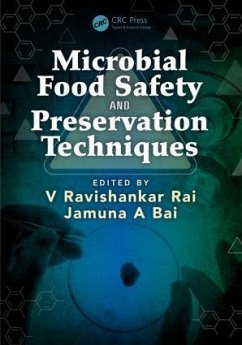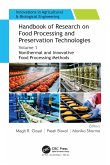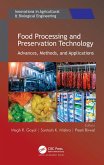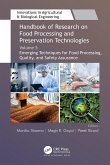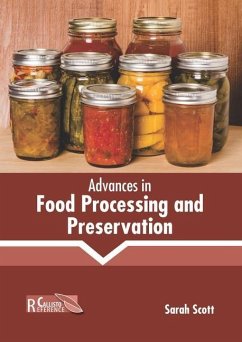Microbial Food Safety and Preservation Techniques
Herausgeber: Rai, V Ravishankar; Bai, Jamuna A
Microbial Food Safety and Preservation Techniques
Herausgeber: Rai, V Ravishankar; Bai, Jamuna A
- Gebundenes Buch
- Merkliste
- Auf die Merkliste
- Bewerten Bewerten
- Teilen
- Produkt teilen
- Produkterinnerung
- Produkterinnerung
The book explores the advances in food safety and food quality control. It covers the hazards posed by the food-borne pathogens, their detection using advanced molecular techniques and nanotechnology, microbiological risk assessment of raw, fresh produce, ready-to-eat (RTE), minimally processed and processed foods. It includes the role of regulatory agencies and authorities in developing strategies to improve the quality and safety of food. It emphasizes the various food preservative techniques that are used to ensure high quality and safe foods.
Andere Kunden interessierten sich auch für
![Food Processing and Preservation Food Processing and Preservation]() H R NaikFood Processing and Preservation154,99 €
H R NaikFood Processing and Preservation154,99 €![Handbook of Research on Food Processing and Preservation Technologies Handbook of Research on Food Processing and Preservation Technologies]() Handbook of Research on Food Processing and Preservation Technologies188,99 €
Handbook of Research on Food Processing and Preservation Technologies188,99 €![Food Analysis and Preservation Food Analysis and Preservation]() Food Analysis and Preservation158,99 €
Food Analysis and Preservation158,99 €![Food Processing and Preservation Technology Food Processing and Preservation Technology]() Food Processing and Preservation Technology186,99 €
Food Processing and Preservation Technology186,99 €![Handbook of Research on Food Processing and Preservation Technologies Handbook of Research on Food Processing and Preservation Technologies]() Handbook of Research on Food Processing and Preservation Technologies195,99 €
Handbook of Research on Food Processing and Preservation Technologies195,99 €![Advances in Food Processing and Preservation Advances in Food Processing and Preservation]() Advances in Food Processing and Preservation146,99 €
Advances in Food Processing and Preservation146,99 €![Emerging Technologies in Food Preservation Emerging Technologies in Food Preservation]() Emerging Technologies in Food Preservation229,99 €
Emerging Technologies in Food Preservation229,99 €-
-
-
The book explores the advances in food safety and food quality control. It covers the hazards posed by the food-borne pathogens, their detection using advanced molecular techniques and nanotechnology, microbiological risk assessment of raw, fresh produce, ready-to-eat (RTE), minimally processed and processed foods. It includes the role of regulatory agencies and authorities in developing strategies to improve the quality and safety of food. It emphasizes the various food preservative techniques that are used to ensure high quality and safe foods.
Hinweis: Dieser Artikel kann nur an eine deutsche Lieferadresse ausgeliefert werden.
Hinweis: Dieser Artikel kann nur an eine deutsche Lieferadresse ausgeliefert werden.
Produktdetails
- Produktdetails
- Verlag: CRC Press
- Seitenzahl: 542
- Erscheinungstermin: 26. September 2014
- Englisch
- Abmessung: 257mm x 183mm x 36mm
- Gewicht: 1134g
- ISBN-13: 9781466593060
- ISBN-10: 1466593067
- Artikelnr.: 40546051
- Herstellerkennzeichnung
- Libri GmbH
- Europaallee 1
- 36244 Bad Hersfeld
- gpsr@libri.de
- Verlag: CRC Press
- Seitenzahl: 542
- Erscheinungstermin: 26. September 2014
- Englisch
- Abmessung: 257mm x 183mm x 36mm
- Gewicht: 1134g
- ISBN-13: 9781466593060
- ISBN-10: 1466593067
- Artikelnr.: 40546051
- Herstellerkennzeichnung
- Libri GmbH
- Europaallee 1
- 36244 Bad Hersfeld
- gpsr@libri.de
V Ravishankar Rai earned his MSc and PhD from the University of Mysore, India. Currently, Dr. Rai is working as a Professor in the Department of Studies in Microbiology, University of Mysore, India. He was awarded a fellowship from the UNESCO Biotechnology Action Council, Paris (1996), the Indo-Israel Cultural Exchange Fellowship (1998), the Biotechnology Overseas Fellowship, Government of India (2008), and the Indo-Hungarian Exchange Fellowship (2011) Indian National Academy Fellowship (2015) and Cardiff Incoming Visiting Fellowship (2017). Presently, he is the coordinator for the Department of Science and Technology, Promotion of University Research and Scientific Excellence and University Grants Commission innovative programs. Jamuna A. Bai has completed her MSc and PhD in Microbiology from University of Mysore, India. She is working as a Researcher in UGC sponsored University with Potential Excellence Project, University of Mysore, India. She has previously worked as ICMR Senior Research Fellow and carried a research work on food safety, role of quorum sensing and biofilms in food-related bacteria and developing quorum-sensing inhibitors. Her research interests also include antimicrobial application of functionalized nanomaterials against food-borne pathogens.
Section 1. Food safety and hygiene. Microbiology of raw, semiprocessed and
processed vegetable and fruit products, meat, poultry and seafoods, dairy
products and fermented foods. Emerging and re-emerging infectious food
borne diseases. Microbial physiology and pathogenicity of food-borne
pathogens -quorum sensing, biofilm formation, infections and toxins.
Detection of food borne pathogens using advanced and rapid molecular
techniques- culture dependent and independent techniques. Application of
nanotechnology and biosensors in pathogen detection and identification.
Microbial risk assessment and risk management of various food products and
quantitative microbial risk assessment tools. Predictive microbiology and
modeling microbial growth in food systems. International and national food
safety regulatory agencies, establishing and developing microbiological
criteria for food borne pathogens, HACCP development, implementation and
impact of regulations and food policies for safety and quality assurance of
foods. Section 2. Food preservation. Microbes in food spoilage - Specific
spoilage organisms, Mechanisms of food spoilage, Interaction between
spoilage organisms, biofilms and biofouling. Modeling microbial growth in
food and extension of shelf life of various food products. An overview of
intervention technologies in food preservation and their advantages and
drawbacks. Biological preservation of foods - bacteriocins, enterocins,
food grade enzymes, chitosans, glucans, essential oils, lactic acid
bacteria and protective cultures. Emerging intelligent and active packaging
techniques, applications and safety concerns. Food preservation by hurdle
technology - A combination of ultrasound, irradiation, pulsed electric
fields, hyperbaric techniques, thermal and non thermal technologies.
Nanotechnology in food preservation and food packaging- application,
limitations and future trends. Quorum sensing inhibitors as novel food
preservatives-dietary phytochemicals as anti quorum sensing agents.
processed vegetable and fruit products, meat, poultry and seafoods, dairy
products and fermented foods. Emerging and re-emerging infectious food
borne diseases. Microbial physiology and pathogenicity of food-borne
pathogens -quorum sensing, biofilm formation, infections and toxins.
Detection of food borne pathogens using advanced and rapid molecular
techniques- culture dependent and independent techniques. Application of
nanotechnology and biosensors in pathogen detection and identification.
Microbial risk assessment and risk management of various food products and
quantitative microbial risk assessment tools. Predictive microbiology and
modeling microbial growth in food systems. International and national food
safety regulatory agencies, establishing and developing microbiological
criteria for food borne pathogens, HACCP development, implementation and
impact of regulations and food policies for safety and quality assurance of
foods. Section 2. Food preservation. Microbes in food spoilage - Specific
spoilage organisms, Mechanisms of food spoilage, Interaction between
spoilage organisms, biofilms and biofouling. Modeling microbial growth in
food and extension of shelf life of various food products. An overview of
intervention technologies in food preservation and their advantages and
drawbacks. Biological preservation of foods - bacteriocins, enterocins,
food grade enzymes, chitosans, glucans, essential oils, lactic acid
bacteria and protective cultures. Emerging intelligent and active packaging
techniques, applications and safety concerns. Food preservation by hurdle
technology - A combination of ultrasound, irradiation, pulsed electric
fields, hyperbaric techniques, thermal and non thermal technologies.
Nanotechnology in food preservation and food packaging- application,
limitations and future trends. Quorum sensing inhibitors as novel food
preservatives-dietary phytochemicals as anti quorum sensing agents.
Section 1. Food safety and hygiene. Microbiology of raw, semiprocessed and
processed vegetable and fruit products, meat, poultry and seafoods, dairy
products and fermented foods. Emerging and re-emerging infectious food
borne diseases. Microbial physiology and pathogenicity of food-borne
pathogens -quorum sensing, biofilm formation, infections and toxins.
Detection of food borne pathogens using advanced and rapid molecular
techniques- culture dependent and independent techniques. Application of
nanotechnology and biosensors in pathogen detection and identification.
Microbial risk assessment and risk management of various food products and
quantitative microbial risk assessment tools. Predictive microbiology and
modeling microbial growth in food systems. International and national food
safety regulatory agencies, establishing and developing microbiological
criteria for food borne pathogens, HACCP development, implementation and
impact of regulations and food policies for safety and quality assurance of
foods. Section 2. Food preservation. Microbes in food spoilage - Specific
spoilage organisms, Mechanisms of food spoilage, Interaction between
spoilage organisms, biofilms and biofouling. Modeling microbial growth in
food and extension of shelf life of various food products. An overview of
intervention technologies in food preservation and their advantages and
drawbacks. Biological preservation of foods - bacteriocins, enterocins,
food grade enzymes, chitosans, glucans, essential oils, lactic acid
bacteria and protective cultures. Emerging intelligent and active packaging
techniques, applications and safety concerns. Food preservation by hurdle
technology - A combination of ultrasound, irradiation, pulsed electric
fields, hyperbaric techniques, thermal and non thermal technologies.
Nanotechnology in food preservation and food packaging- application,
limitations and future trends. Quorum sensing inhibitors as novel food
preservatives-dietary phytochemicals as anti quorum sensing agents.
processed vegetable and fruit products, meat, poultry and seafoods, dairy
products and fermented foods. Emerging and re-emerging infectious food
borne diseases. Microbial physiology and pathogenicity of food-borne
pathogens -quorum sensing, biofilm formation, infections and toxins.
Detection of food borne pathogens using advanced and rapid molecular
techniques- culture dependent and independent techniques. Application of
nanotechnology and biosensors in pathogen detection and identification.
Microbial risk assessment and risk management of various food products and
quantitative microbial risk assessment tools. Predictive microbiology and
modeling microbial growth in food systems. International and national food
safety regulatory agencies, establishing and developing microbiological
criteria for food borne pathogens, HACCP development, implementation and
impact of regulations and food policies for safety and quality assurance of
foods. Section 2. Food preservation. Microbes in food spoilage - Specific
spoilage organisms, Mechanisms of food spoilage, Interaction between
spoilage organisms, biofilms and biofouling. Modeling microbial growth in
food and extension of shelf life of various food products. An overview of
intervention technologies in food preservation and their advantages and
drawbacks. Biological preservation of foods - bacteriocins, enterocins,
food grade enzymes, chitosans, glucans, essential oils, lactic acid
bacteria and protective cultures. Emerging intelligent and active packaging
techniques, applications and safety concerns. Food preservation by hurdle
technology - A combination of ultrasound, irradiation, pulsed electric
fields, hyperbaric techniques, thermal and non thermal technologies.
Nanotechnology in food preservation and food packaging- application,
limitations and future trends. Quorum sensing inhibitors as novel food
preservatives-dietary phytochemicals as anti quorum sensing agents.

